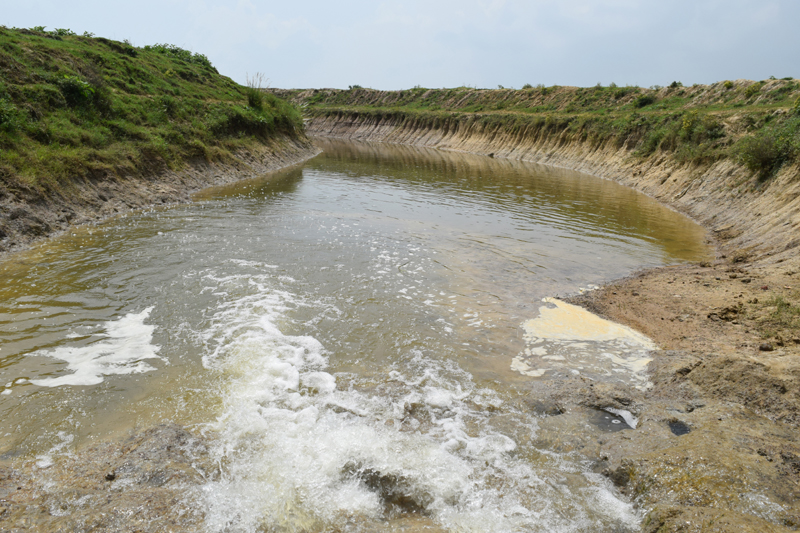
RAJSHAHI, August 9, 2024 (BSS)- Surface water irrigation appeared to be a
best tool to mitigate the gradually mounting pressure on underground water in
the drought-prone Barind area having scores of natural water bodies which
currently remain in uncared and derelict condition.
Prof Niamul Bari said surface water conservation can be the crucial means of
mitigating the water crisis, which is being deepened due to deficit rainfall,
in the region, including its vast Barind tract.
Inadequate rainfall has been escalating the crises in the region for the last
couple of decades.
Prof Bari who teaches at the Department of Civil Engineering in Rajshahi
University of Engineering and Technology (RUET), said there are enormous
scopes of enriching the surface water resources through proper management of
the water bodies.
Prospects of boosting irrigation by surface water are very bright as it has
scores of natural water bodies which remain in uncared and derelict condition
at present.
Referring to various research findings Prof Chowdhury Sarwar Jahan said there
are around 10,000 ponds, 200 canals and 10 other big sized waterholes in the
barind areas comprising Rajshahi, Chapainawabganj and Naogaon districts.
He cited the instance of Beelbhatia, a vast water body and wetland of around
6,388 acres, at Bholahat upazila in Chapainawabganj district. Tens of
thousands hectares of farmlands can be irrigated round the year through using
conserved water of the beel if it was re-excavated.
Prof Chowdhury who teaches at the Department of Geology and Mining in
Rajshahi University (RU) has been conducting research on both surface and
groundwater resources in the drought-prone Barind area for a long time.
There is another four to five kilometer long water body at Rohanpur in
Gomastapur upazila of the same district. If it was re-excavated, around
10,000 hectares of land of 25,000 farmers can be brought under surface water
irrigation.
Apart from this, the two-kilometer Chowdala-Boalia canal remained in derelict
condition for a long time. Around 150 hectares of farmlands can be irrigated
with water from the canal if it was re-excavated, Prof Chowdhury added.
Transforming all the existing underground water-based irrigation into surface
water ones can be the crucial means of lessening the gradually mounting
pressure on groundwater tables.
He mentioned that the gradually declining water resources are posing a
serious threat to the living and livelihood conditions of the marginalized
and other less-income group families in the water-stressed area.
Meanwhile, Barind Multipurpose Development Authority (BMDA), an ever-largest
irrigation-providing state-owned entity in the country's northwest region,
has been implementing a project titled "Small irrigation through pond re-
excavation and surface water augmentation" for the last couple of years.
BMDA Additional Chief Engineer Abdur Rashid said the five-year project is
being implemented in 43 drought-prone upazilas of Rajshahi, Chapainawabganj,
Naogaon, Bogura and Natore districts with an estimated cost of around Taka
128.19 crore.
Around 715 more derelict ponds and 10 other big closed water bodies will be
brought under re-excavation aimed at making those suitable for use to both
irrigation and household purposes in the region including its vast Barind
tract within near future.
Upon successful implementation by December in 2023, the project will create
scope of providing irrigation to 3,058 hectares of farming fields for
yielding around 18,348 tonnes of additional crops yearly.
In addition, the scope of producing 1,088 tonnes of additional fish will be
created through the conserved water.
The initiative will contribute a lot towards improving surface water
resources besides aquifer recharge in the drought-prone areas.
It will also help reduce the gradually mounting pressure on underground water
side by side encouraging the people to boost the farming of fish and duck
after the best uses of the conserved water.
Earlier, the BMDA had re-excavated 3,098 ponds, 2,011-kilometer canal and 413
dug-wells through implementation of various other projects in order to
promote surface water-based irrigation till June last, Engineer Rashid said.
"We have a plan of elevating the surface water-based irrigation to 30 percent
from the existing 10 percent by 2030 in order to lessen the gradually
mounting pressure on underground water," he added.